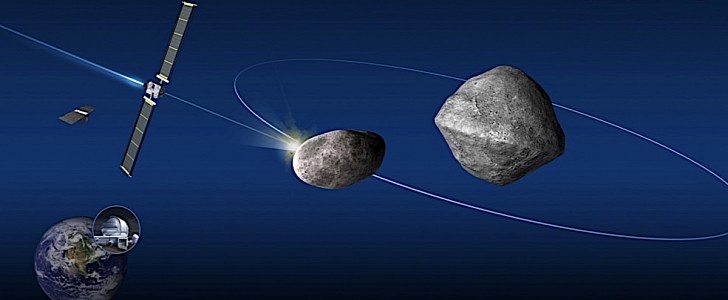At the end of April, a bunch of scientists came together to see how prepared humanity is to stop an asteroid from impacting our planet. The bottom line is that if we were to discover an asteroid heading our way six months in advance, we would probably not be able to do anything to stop it.
And it was not for the lack of trying. The American space agency tried everything from deflection to disruption during the exercise, but nothing worked because we don’t have the needed infrastructure for spacecraft and launch to make any solution possible.
But that doesn’t mean NASA isn’t training for when we will be ready.
In November 2021, the space agency will launch the Double Asteroid Redirection Test mission. DART for short, the spacecraft will be aimed at Didymos, a binary near-Earth asteroid with the main rock 780 meters (2,560 feet) across, and the smaller one 160 meters (525 feet) across.
It is the smaller piece of floating danger NASA targets with DART. More to the point, the spacecraft will be purposefully smashed into the small asteroid, in an attempt to change its speed and orbit by a fraction of one percent. That may seem tiny, but it should translate into a change in the orbital period of the moonlet by several minutes - enough to be seen from Earth using telescopes.
DART is part of NASA’s planetary defense plans for the future. If it works, it will definitely prove kinetic impacts can change the course of asteroids, but it will of course not solve the infrastructure problems we’ll still be forced to overcome if a real threat were to come toward us.
Below is a short animation of how the whole thing is supposed to work. It’s not an official NASA video, but one put together by Hazegrayart, one of the many fans of all space stuff out there. It may seem utterly unspectacular, probably just as the real thing will be, but worth watching as this might very well be the unspectacular start of the future of planetary defense systems.
But that doesn’t mean NASA isn’t training for when we will be ready.
In November 2021, the space agency will launch the Double Asteroid Redirection Test mission. DART for short, the spacecraft will be aimed at Didymos, a binary near-Earth asteroid with the main rock 780 meters (2,560 feet) across, and the smaller one 160 meters (525 feet) across.
It is the smaller piece of floating danger NASA targets with DART. More to the point, the spacecraft will be purposefully smashed into the small asteroid, in an attempt to change its speed and orbit by a fraction of one percent. That may seem tiny, but it should translate into a change in the orbital period of the moonlet by several minutes - enough to be seen from Earth using telescopes.
DART is part of NASA’s planetary defense plans for the future. If it works, it will definitely prove kinetic impacts can change the course of asteroids, but it will of course not solve the infrastructure problems we’ll still be forced to overcome if a real threat were to come toward us.
Below is a short animation of how the whole thing is supposed to work. It’s not an official NASA video, but one put together by Hazegrayart, one of the many fans of all space stuff out there. It may seem utterly unspectacular, probably just as the real thing will be, but worth watching as this might very well be the unspectacular start of the future of planetary defense systems.


